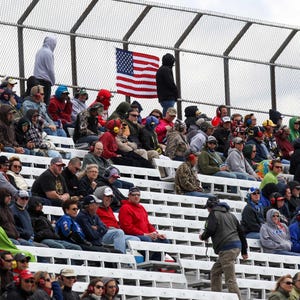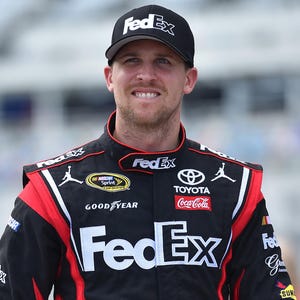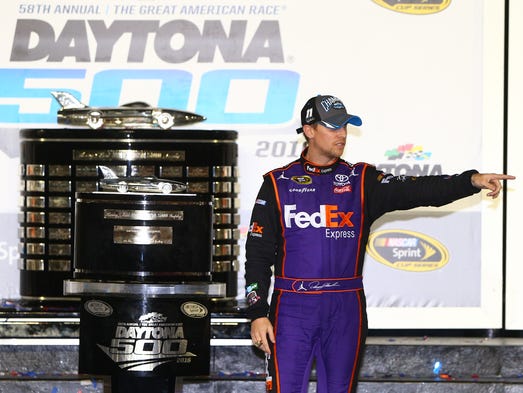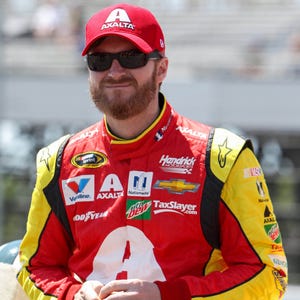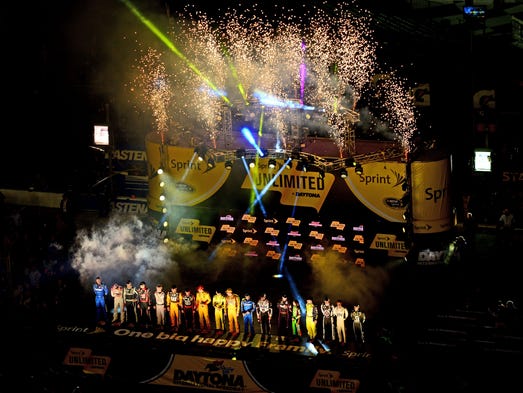NASCAR looks beyond declining attendance, TV ratings – USA TODAY

USA Today Sports’ Jeff Gluck looks ahead to the Coke Zero 400 at Daytona International Speedway and the story lines that fans should keep an eye on during the week.
USA TODAY Sports
On a beautiful April day in the Tennessee mountains, sunlight glistened off tens of thousands of empty seats at Bristol Motor Speedway.
Unlike in the previous few seasons, there was no ominous weather in the forecast. NASCAR was enjoying a spectacular start to the season with thrilling finishes and close-quarters racing, thanks in part to a new rules package.
But in Bristol’s 146,000-capacity stadium, there appeared to be at least as many empty seats as occupied ones.
Scenes such as the one at Bristol — which once sold out 55 consecutive races — have been jarring as attendance has fallen over the last decade. NASCAR stopped providing attendance estimates after 2012. Negative headlines about the sport’s health have blossomed since attendance began to fall, and the crowds have only shrunk since. And ratings show not as many are watching the sport on television, either.
Fox and Fox Sports 1 broadcast the first 16 Sprint Cup races this season. Ratings in seven of eight races on Fox were down from 2015, and four of those were the lowest since Fox began broadcasting races in 2001, according to SportsMediaWatch.com.
And the sport continues to search for a primary sponsor to fill the void that Sprint — which came on in 2004 as Nextel and announced its departure in December 2014, citing a change in its marketing focus — will leave at season’s end.
Whether attendance rebounds, NASCAR and its tracks are on solid financial ground, thanks to the 10-year, $8.2 billion TV package with Fox and NBC that runs through 2024.
As NASCAR enters the summer portion of its 36-race Cup schedule, the remaining 20 of which will air on NBC or NBC Sports Network starting at Daytona International Speedway this weekend, the question looms: Do the drops in attendance and TV ratings signal waning interest or reflect changes in how fans across all sports consume events?
International Speedway Corp. and Speedway Motorsports Inc. — the publicly owned corporations that operate 20 of the Cup series’ 23 tracks — have seen attendance revenue fall. According to a review of the companies’ annual reports, ISC’s attendance revenue is down 49% from its highest point, in 2007; SMI’s is down 46% from its peak, in 2008.
“The struggle with keeping fans engaged as the Baby Boomer generation is exiting and the younger Millennial generation is entering — the struggle is real,” 2012 Sprint Cup champion Brad Keselowski said. “You see that with the technology we have today: It is easier than ever to get access to different platforms without attending. That is a lot of how the sport is monetized, through actual attendance.”
But as to the cause of the attendance slide? It’s rare to find two people with the same opinion.
“It’s everything,” Texas Motor Speedway President Eddie Gossage said. “There’s no one thing that’s impacting it.”
USA TODAY Sports asked about 200 fans at tracks, on the phone and on social media who have reduced their racetrack trips to explain why. The three most-cited reasons:
–Cost. Fans said tickets are the smallest impact on their financial decision, because ticket prices are dwarfed by the cost of hotel rooms and transportation to events.
–NASCAR’s competition-related decisions and constant rules changes have hurt the sport’s credibility and turned off some traditional fans, such as Jim and Lanette Williams, who opted to travel and see more of the USA instead of spending many weeks a year following NASCAR. “The constant changes NASCAR does, it doesn’t have the same good feeling it used to have,” Lanette Williams, 63, told USA TODAY Sports. “We’ve just lost interest in NASCAR. NASCAR has lost interest in us.”
–The experience is different. Instead of a midway with souvenir haulers, there’s now one merchandise tent area. Prerace entertainment such as the Sprint Experience and Fox’s NASCAR RaceDay TV stage are gone.
But NASCAR sees attendance and TV ratings as shallow measures of the sport’s overall consumption. They’re important metrics, NASCAR chief operating officer Brent Dewar told USA TODAY Sports, but don’t tell the whole story. What’s important in today’s world for sports fans, Dewar said, is overall engagement. And Dewar thinks when digital and social metrics are factored in, NASCAR is as popular as ever.
“It used to be in the old days about the numbers and the attendance,” Dewar said. “When we get into numerology discussions, I think we’re being way too simplistic about how all sports have evolved. … The numbers matter and attendance matters, but it’s about the quality of the experience. And that’s where you see us investing heavily.”
Part of that investment has been an industry trend of downsizing its venues.
ISC and SMI have combined to remove nearly a quarter of their venues’ capacity — 475,000 seats in all — in the last five years. The seats were no longer being filled, and the optics of so many empty seats — as at Bristol — has raised questions about the sport’s health.
But at the same time, the tracks have seized upon the opportunity to improve the live experience by moving all seats to the frontstretch (so fans can see pit stops and the big screen) and focusing resources on amenities there.
“A fan that attends a live event is an absolute keystone of the sport for us,” Dewar said. “If the experience is awesome and they have all the amenities they want, all of our research points to the fact you have a chance to make a fan for life.”
‘Die-hards are … fading’
While the economic downturn of 2008 and its continued impact on the middle class is undoubtedly a factor, finances are just one of the reasons for falling attendance.
“When we do research, we see a whole series of reasons,” Kansas Speedway President Pat Warren told USA TODAY Sports. “There’s not one thing that you can say, ‘We can fix this and all of a sudden the sport will be where it was in 2005.’ ”
Much like the housing market, NASCAR experienced a bubble in the mid-2000s. Its popularity skyrocketed, evidenced by TV ratings, attendance and sponsors beating down the door. It was named “America’s Fastest Growing Sport” by Fortune in 2005 and the same year was second in the Newsmaker Brands survey — behind BlackBerry but ahead of Google, iPod and Desperate Housewives.
But in chasing a new audience — and a demographic beyond its traditional base — NASCAR’s old school fans felt spurned. When the trendiness wore off and casual viewers moved on to the next hot thing, some of NASCAR’s core followers had left, too.
Changes such as scrapping the season-long points system for a playoff, implementing the Car of Tomorrow, adding gimmicks (the free pass, green-white-checkered finishes and double-file restarts) and moving several races from the South turned out to be anathema to some longtime fans.
“They’ve abandoned the base,” Stephen Lay, 42, a fan from Olive Branch, Miss., told USA TODAY Sports. “I’ve already stopped spending my money. … The die-hards are slowly fading away, one at a time.”
Conflicting opinions
In an April conference call with investors, ISC President John Saunders cited the retirement of four-time champion Jeff Gordon as one reason for softer advance ticket sales. He also said the absence of then-injured Tony Stewart and the shifted emphasis on NASCAR’s 10 Chase for the Sprint Cup playoff races were factors.
Around the garage, the Gordon retirement has been a popular theory to explain why attendance and TV ratings have experienced some year-over-year declines.
Gordon, though, isn’t buying it.
“It’s flattering to hear that some think me not being in the car contributed to lower attendance this season, but I don’t necessarily agree with that argument,” Gordon said in a statement to USA TODAY Sports. “NASCAR has done a great job with the new rules package, and we have had some tremendous racing this year. I believe this great racing and these great finishes will continue — and I’m hopeful that will lead to increased attendance at tracks in the months and years to come.”
Gossage says no driver makes that much of an impact on ticket sales. Even if Dale Earnhardt Jr. announced he was running the fall Xfinity Series race at Texas, Gossage said, there wouldn’t be a noticeable difference in ticket sales.
“No one driver is going to sell you tickets, and no one driver is going to put you out of business,” he said. “Each driver represents a slice of the pie that makes up the whole.”
When it comes to TV ratings, the issue might be generational because NASCAR fans are disproportionately older. According to ShowBuzzDaily.com, Fox Sports 1 had a 2.27 rating for adults 50 and older during the recent race at Michigan International Speedway. The rating was the highest on cable for the demographic that day, even beating Game of Thrones.
But the rating for adults ages 18-49 was 0.71, which tied for fourth with an episode of Keeping up with the Kardashians.
The difference between the generations?
“(Cars are) a way of transportation for (the younger fans), but it’s not something they’re hooked on,” said Dale Jarrett, a NASCAR Hall of Famer and NBC Sports analyst. “It doesn’t seem they have that desire anymore. And let’s face it: The attention span of the younger generation now because of everything that’s out there to do (is shorter).”
NASCAR says it is generating strong interest in that 18-49 group but not in the traditional way. Consumption habits are changing, and it’s easy to follow a race via mobile device from live-streaming to social media updates through outlets such as Twitter.
NASCAR’s social media channels have piled up nearly 2 billion social impressions (the number of times its content was viewed) and more than 92 million fan engagements (retweets, likes, shares) this year. And its website is averaging 9 million unique visitors a month, according to NASCAR.
Said Dewar, “Attendance is a very important metric. but it’s just one important metric. … What will drive the sport to grow is for the fan to be as deeply engaged as possible. In the broadest sense, you grow by expanding the engagement.”
But it’s difficult to say how much engagement is the same as a rear end in a seat or a pair of eyes watching a race on TV.
“Digital is how the world is consuming everything, but digital is still new,” Zak Brown, executive chairman of Just Marketing International, told USA TODAY Sports. “I don’t think anyone has figured out how to quantify digital exposure yet.”
Being proactive
As NASCAR’s stars walked along a red carpet leading to the prerace drivers meeting at Charlotte Motor Speedway, children lined up along the inside of a fence with hopes of getting autographs, part of a NASCAR initiative to connect younger fans to its stars.
Such initiatives are examples of what NASCAR views as unprecedented collaboration in the industry. There’s a drivers council, a manufacturers council, an owners alliance and, beginning this year, a track council.
The 10-member track council — which includes representatives from ISC, SMI and the independent tracks — has met twice this year. NASCAR is hoping to generate communication among the tracks on ideas that can be implemented at every venue.
In addition, NASCAR points to the schedule consistency generated by all tracks signing five-year sanctioning agreements, which went into effect this year, as something that will help attendance.
“We have to find the value package that connects to a new generation of fans,” Keselowski said. “If we have initiatives like (kids on the red carpet), hopefully they will turn into our future fans. I think everybody agrees that is the right direction.”
Ultimately, NASCAR and its teams need sponsorship to survive. But attendance and TV ratings might not matter to companies as long as NASCAR has a positive impact on their bottom lines.
“As long as the needle is moving on their business, that’s ultimately their No. 1 measurement,” Brown said. “Measuring eyeballs and attendance is less than, ‘Did I sell more cans of Coke? Did I sell more Subway sandwiches?’ As long as those metrics say, ‘I sold more because of my NASCAR sponsorship,’ that becomes priority No. 1.”
Contributing: Mike Hembree
Follow Gluck on Twitter @jeff_gluck and Hembree @mikehembree

